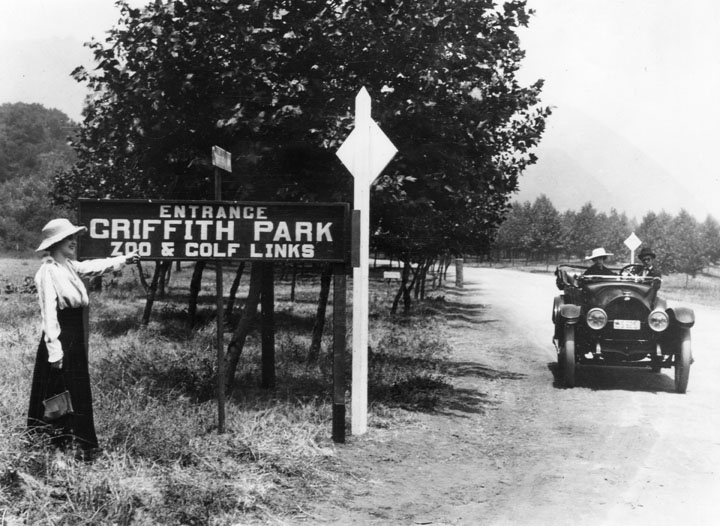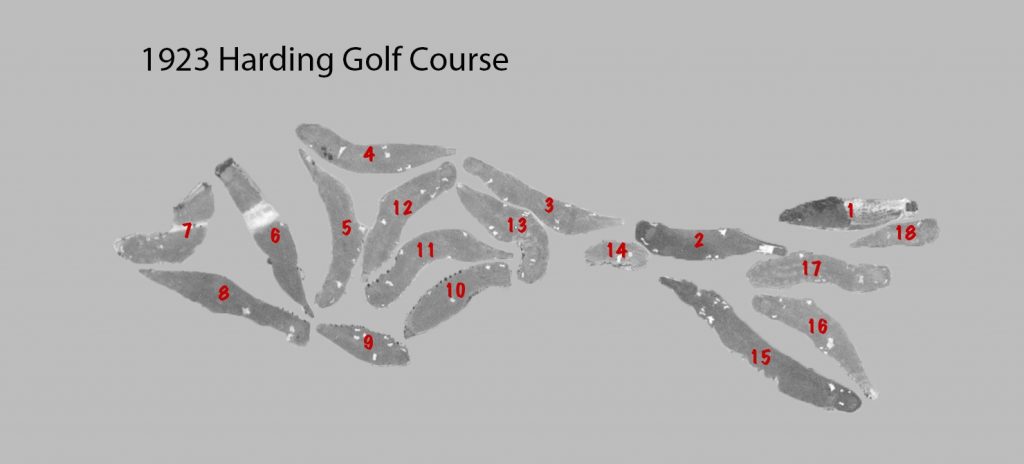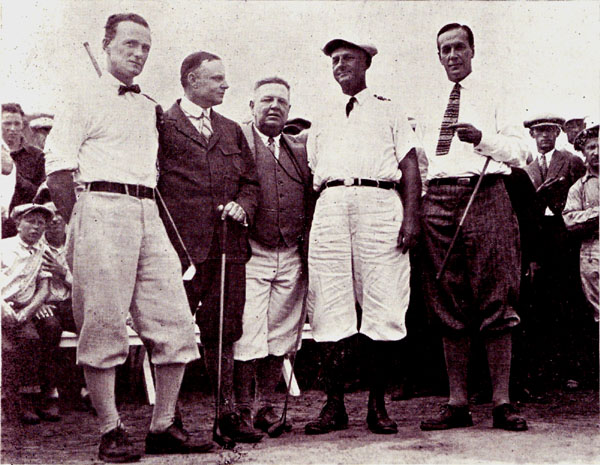So, you're coming to L.A. for the @usopengolf
— Golf Historical Society (@GolfHistorical) June 6, 2023
What you need to know: George C. Thomas Jr's first 18-hole golf course was Harding in Griffith Park in 1923. He also designed Wilson, which opened in 1927. Both are very original except for some greens & tees.https://t.co/VkfedLdCYH
Category: George C. Thomas Jr.
Griffith Park Wilson compare – hole No. 16, by George C. Thomas Jr.
My Book on Griffith Park golf history! Tom Bendelow and George C. Thomas!
125 Years of Griffith Park. 107 Years of Golf

Griffith Park was donated to the city of Los Angeles by Griffith Jenkins Griffith and his wife Christina Mesmer Griffith at Christmas of 1896. This November 13 the Recreation and Parks Department are celebrating the 125th anniversary of that gift.
The first Griffith Park municipal golf course, No. 1, opened on November 1, 1914, with the support of members of the Los Angeles Country Club and the Southern California Golf Association. It was a sand green links designed by golf legend Tom Bendelow and was located under Wilson #1,2,18, and Harding #17 and 18, west of the old city water pipe.
The old links were much loved by the country club crowd. They were also the site of many a film star hitting balls between takes. Griffith Park was location #1 in the late teens! Many athletes, celebrities, and other sports stars visited Los Angeles in the winters. Babe Ruth even signed his Yankee contract while playing Municipal No. 1 in 1920.
In 1923 George C. Thomas Jr., designed new municipal, No. 2, Harding Memorial, and in 1927 the Wilson Memorial, both all-grass golf courses. Nine holes of the old sand course, which are now part of the Zoo, were kept, and grassed-over in the 1930’s, and renamed the Roosevelt Memorial Golf Course.
In the early 1930s, superintendent of golf, William Johnson, and architect William P. Bell, modernized the courses using Federal Works money, installing irrigation and building the current clubhouse by 1936. It replaced the English style field house of 1918. Both Wilson and Harding courses were used for the L.A. Opens of 1937-1939.
After the great flood of 1938, the L.A. River was channelized to protect the park from flood damage. The county road was built in the 1920s along the river bank, and their “right of way” became the battle over the 5 Freeway in the late 1950s. The golf holes along the county road were taken during construction, but the land was returned afterward, with new holes designed to replace them.
Later, Wilson lost three more holes that became the Crystal Springs picnic area. There is also an old par 3 that had been the 18th and then the 16th hole on Thomas’s Harding, located between the 1st and 17th holes, which was abandoned in the 1950s.
In the early 1960s the city of L.A. wanted a new Zoo, and decided to replace the old Roosevelt golf course. The uproar caused the construction of the new Roosevelt golf course in Vermont Canyon, which was built to replace the historic remnant of the original 1914 Municipal No. 1. Both courses were open on the same day in 1964, after which the turf grass from the old course was spread around the city’s other courses.
Griffith Park was also home to the Coolidge Memorial course, now called the Tregnan Academy, the Los Feliz driving range and Par 3 course, and the nine-hole putting course on the second floor of the Griffith Park Bath House.
Los Angeles Recreation and Parks should be very proud of their accomplishments, having turned the original 18-hole sand course into a golf system that today has twelve courses that have been funded by the receipts from Griffith Park and later Rancho Park.
Come out on the 13th of November and enjoy the beautiful gift of the park and all of the awesome facilities that we in Los Angeles are so proud to have!
©2021 jib jones – golfhistoricalsociety
Whittier, La Habra Heights, Hacienda Country Club’s 100th Anniversary!
The Whittier Country Club was founded in 1920 by real estate developer and ex tennis champion Alphonzo Bell. The new Quaker Colony golf course was designed in the summer of 1920 by Scotch American course architect and golf equipment supplier, William Watson of St. Andrews, Chicago, and Los Angeles, on 151 acres of land owned by Bell in the center of the 3600 acre La Habra Heights subdivision.
In December of 1920, Alphonzo Bell formed the Hacienda Land Company and the Hacienda Country Club, and was looking for a “pro” to build the Watson designed course. He asked old tennis friend Ed Tufts of the local golf association and the Los Angeles Country Club for help. Tufts and legendary golf course architect George C. Thomas Jr., visited the site and made valuable alterations to the Watson design while making a plan for a modern irrigation system.
By Christmas Bell hired visiting English professional Charles Mayo to supervise construction of the course. Mayo was the former playing partner of British Open champion George Duncan, and had been lured to the USA in the summer of 1920 by Chick Evans to be the new professional at the Edgewater Club in Chicago.
In December Mayo was in Los Angeles, managed by D. Scott Chisholm, and playing in the opening exhibition match at the Wilshire Country Club and winning the big professional tournament at Pasadena Golf Club. By February, after a trip to San Francisco for exhibition matches, Charles completed construction of the first nine holes at Hacienda. A visit to the course that month by renowned grass expert William Tucker confirmed the work was completed, but with temporary greens.
Bell then hired John S.C. Shaw as Greenkeeper, and the nearly 300 members started playing the temporary course under the professional Perry Gaile. Shaw would carry on construction of the second nine to Watson and Mayo’s plan.
The new Bermuda greens and fairways of the first nine holes were officially opened on September 19, 1921, and the Hacienda Country Club joined the Southern California Golf Association (SCGA) in November.
Aside from real estate development, Alphonzo Bell also invested heavily in oil drilling. He was in over his head in debt when he opened the Hacienda Country Club in September. Fortunately his Bell No. 1 Oil Well in Santa Fe Springs exploded into gushing flames in October and forced Bell and his family to move to the Beverly Hills Hotel in the middle of the night just days after the Hacienda opening!
Once the well was brought under control it produced 2,000 barrels a day. Liquid money!
The Hacienda club had twelve holes in play in 1922, but the opening of the full eighteen holes was not until December 22, 1923. The official eighteen-hole opening featured an exhibition match between Willie Hunter and home pro Harry Pressler, who defeated George Kerrigan and Dick Linares, 2 and 1.
Soon after, Alphonzo Bell would concentrate on his new oil bought investments, the 1,700 acre Bel-Air subdivision, and his later purchase of the Santa Monica Mountain Park Company, and had little to do with Hacienda Country Club after 1924.
©2021 jibjones golfhistoricalsociety
The Warren G. Harding Memorial Golf Course turned 98 on August 11, 2021.
Harding Municipal Golf Course in Griffith Park, Los Angeles, opened on August 11, 1923, as Griffith Park Course No. 2. It was the first all-grass links in the park. A country club for the masses!

Name: Griffith Park Course No. 2, Warren G. Harding Memorial (renamed 1924)
Nickname: Riverside
Course: 18 Hole, all grass tees and greens.
Yards: 6423 yards
Par: 444444453 – 444435443 – 36 – 35 – 71
Open: August 11, 1923 – Postponed from August 4, due to the death of President Harding on August 3.
Green Fee: $1
Ten plus holes remain from the original 1923 layout.
Harding – 1,2,3,5,6,14,16, (4, tee, fairway – 1923 H13)
Wilson – 5,6,13 (10, tee, fairway – 1923 H10)
Architect: George C. Thomas Jr.
Construction Committee: chair. Edward B. Tufts (SCGA, CGA, LACC), Mrs. Ann Trabue (chair. Golf Advisory Board)
Assistants: Max Behr, William P. Bell
Superintendent: Carl Worthen
Professional: S.C.P.G.A. sec. J.A. “Pat” Patterson (absent – at National Open)
Park Commission: Pres., Mrs. Martha McCann, master of ceremonies
City of L.A.: Councilman Ralph Criswell (filling in for Mayor Cryer) accepted the new course from Ed Tufts.
Opening Exhibition Matches – 1 PM

The designer of the course, George C. Thomas Jr., drove the first ball in an amateur foursome. He was paired with Southern California and British Amateur champion, Willie Hunter, playing against Wilshire CC’s, Norman Macbeth and Annandale’s A.D.S. Johnston. Hunter and Thomas won the 18 hole match, 1 up.
The amateurs were followed by a foursome of professionals led by LACC’s Vic Dalberto and ex-LACC and Open champion Hutt Martin, who won their match, 3 up 2 to play, from Midwick Country Club’s Chick Fraser and Pasadena Golf Club’s Mel Smith.
The following day the course was open to the public for $1 green fee. Over 400 golfers played Course No. 2 (Harding), and 250 played the old No. 1 sand-green links.
What a gift they gave us!
©2021 jib jones – golfhistoricalsociety
The Opening of Los Angeles Country Club’s W. Herbert Fowler designed North course in 1921
It was with great anticipation that Los Angeles Country Club’s new North course at Beverly officially opened to members on Wednesday, August 10, 1921, making LA CC the first club in California to have adjoining eighteen hole golf courses. The new course had been “thrown open for practice,” in early June, and members had declared it couldn’t be improved.
The big event of the opening day was an exhibition match between green committee man, George C. Thomas Jr., who laid out the W. Herbert Fowler designed eighteen hole golf course, paired with Miss Doreen Kavanagh, Southern California and State amateur champion, playing against Southern California amateur champion and general manager of Catalina Island Company, Everett Seaver, and Northern California women’s champion, Miss Margaret Cameron.
Thomas and Kavanagh defeated Cameron and Seaver by a score of 3 up and 3 to play. Broken down, Thomas beat Seaver, 1 up, and Kavanagh beat Cameron 3 and 2, in what was called a keen match.
After the exhibition there was a dinner and dancing for 400. The day’s events were filmed.
The club’s Superintendent of Grounds for many years was Charles Cavanaugh. He and his crew did an amazing job building and rebuilding holes for both new golf courses in under a year, all while keeping 18 holes open for competition.
Alex J. Morrison, of Los Angeles Municipal, Catalina Island, and vaudeville, who had started at LACC as a caddy at Pico and Western, was appointed professional in July of 1921, replacing golf legend John Duncan Dunn and his team of British golfers. Morrison’s assistants were Vic Dalberto and Harry McNamara. Alex was soon back on stage and replaced at LACC by Alex Duncan, brother of earlier LACC professional James Duncan, and British golf legend George Duncan.
There was so much praise heaped on George C. Thomas Jr., for laying out the North course, that Herbert Fowler got more than a bit lost in the press releases. Fowler was a very busy man that summer, having completed the South and North courses for LA CC, the Ambassador-Rancho Golf Club, redesigns of Del Monte #1 and #2 (Pebble Beach), and designs for the Presidio, Olympic Club, Burlingame, Crystal Springs and others.
The North course still has 12-13 original holes laid out by Fowler that were reconstructed by William P. Bell to George C. Thomas Jr.’s redesign in 1928, when they also added five new holes. The 2010 Gil Hanse restoration was to the 1928 Fowler-Thomas-Bell version of the North, plus rebuilding the old Fowler par three 17th (replaced in 1928), which is now an extra hole.
On August 10, 2021, we can celebrate the design brilliance of Herbert Fowler, George C. Thomas Jr., and William P. Bell, along with the restoration by Gil Hanse. Happy 100th Birthday LA CC North!
©2021 J.I.B. Jones -golfhistoricalsociety.org
